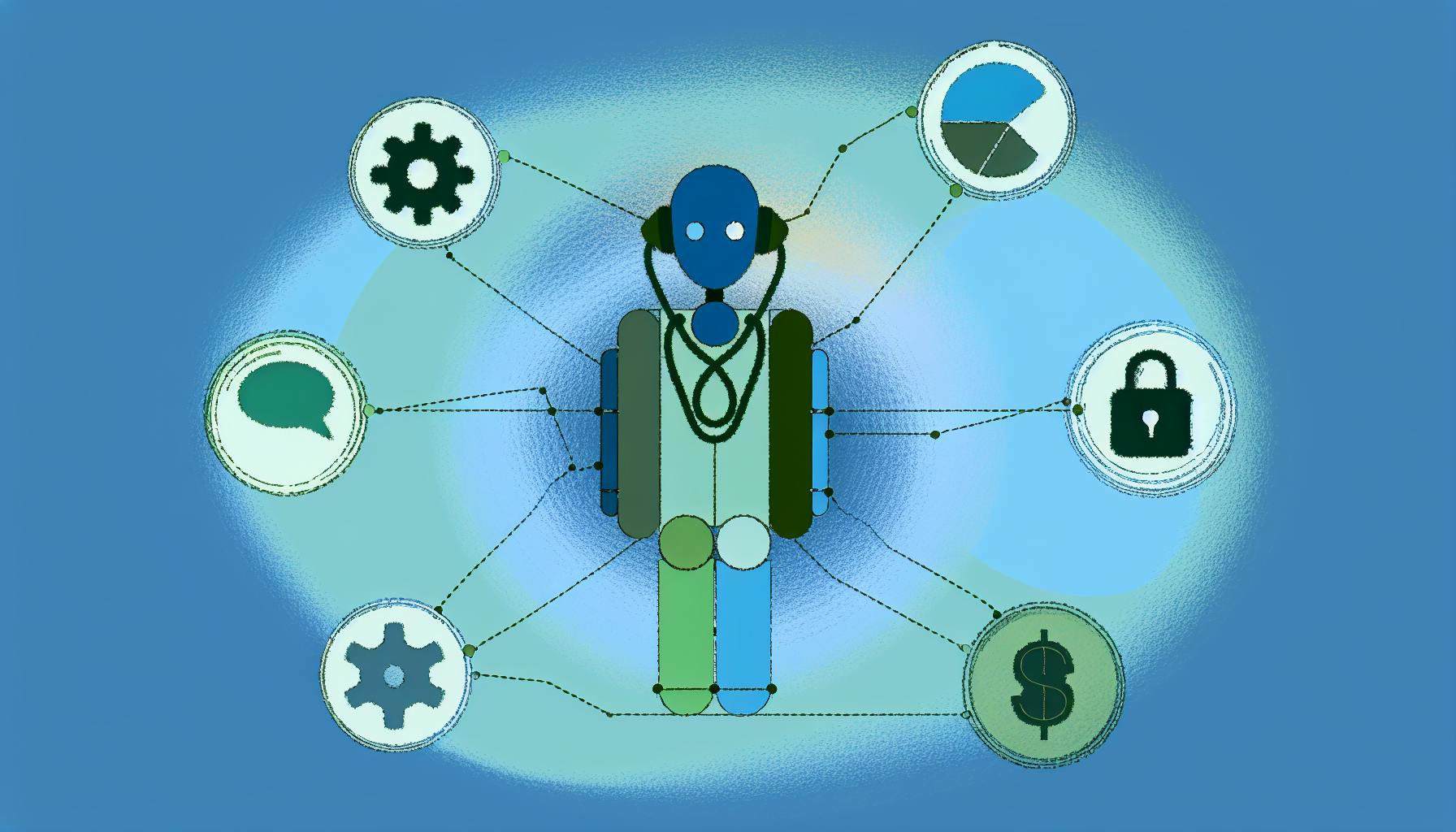AI scribes are transforming telehealth by using AI and natural language processing to automatically generate accurate clinical notes from patient interactions. This frees up healthcare providers to focus on delivering quality care.
Key Benefits of AI Scribes
- Reduce clinician workload by automating documentation tasks
- Improve patient care with accurate, up-to-date records
- Enhance efficiency by streamlining clinical workflows
Choosing an AI Scribe Solution
When selecting an AI scribe tool, consider these key factors:
- Note quality and transcription accuracy
- Workflow integration and customization
- Human review for quality assurance
Popular AI Scribe Solutions
| Solution | Key Features | Benefits |
|---|---|---|
| Nuance DAX | Advanced speech recognition, real-time notes, EHR integration | High accuracy, seamless workflow |
| Suki, Augmedix | Accurate notes, customizable templates, EHR integration | Cost-effective, quality control |
| Chartnote | Basic note generation, limited customization | Entry-level option for individuals |
Implementing AI Scribes
- Choose the right solution for your practice's needs
- Conduct a needs assessment to identify improvement areas
- Develop an implementation plan with training and support
- Monitor and evaluate progress for continuous optimization
The future of AI scribes promises new capabilities like integration with wearables, natural language processing for unstructured data, and advanced analytics for improved patient care and population health management.
Benefits of AI Scribes in Telehealth
The integration of AI scribes into telehealth has brought numerous advantages for healthcare professionals and patients. By automating administrative tasks, AI scribes enable clinicians to focus on delivering high-quality patient care.
Reducing Clinician Workload
AI scribes significantly reduce the administrative burden on healthcare professionals. By automating tasks such as note-taking, data entry, and documentation, AI scribes free up clinicians to spend more time on direct patient care. This reduction in workload leads to:
- Improved job satisfaction
- Decreased burnout rates
- More time for patient care
Moreover, AI scribes can process and analyze large amounts of data quickly and accurately, reducing the time spent on tasks such as chart reviews and medication reconciliations. This enables clinicians to make more informed decisions and improve patient outcomes.
Improving Patient Care
The use of AI scribes in telehealth also has a direct impact on patient care. With accurate and timely documentation, clinicians can provide more personalized and effective treatment plans. AI scribes ensure that patient records are up-to-date, complete, and easily accessible, enabling healthcare professionals to:
- Make informed decisions
- Provide high-quality care
- Focus on patient education
AI scribes facilitate better communication between healthcare providers, patients, and caregivers. By providing accurate and concise documentation, AI scribes enable healthcare professionals to focus on patient education, ensuring that patients are better informed and more engaged in their care.
Overall, the benefits of AI scribes in telehealth are undeniable. By reducing clinician workload and improving patient care, AI scribes are revolutionizing the way healthcare is delivered, making it more efficient, effective, and patient-centered.
sbb-itb-527d68c
Choosing an AI Scribe Solution
When selecting an AI scribe solution for your telehealth services, it's crucial to identify the essential features and functions that meet your healthcare practice's specific needs. This section will guide you through the critical factors to consider when choosing an AI scribe tool.
Note Quality and Transcription Accuracy
The accuracy and quality of clinical notes generated by an AI scribe tool are vital for patient care and record-keeping. Look for a solution that produces structured and accurate notes, ensuring that essential information is captured and easily accessible.
| Note Quality Requirements | Description |
|---|---|
| Accurate transcription of medical terminology and jargon | Ensure the AI scribe tool can accurately capture complex medical terms and jargon. |
| Capture of relevant patient information | The solution should be able to capture essential patient information, including medical history and medications. |
| Concise and clear note generation | The AI scribe tool should generate notes that are easy to understand and concise. |
| Seamless EHR system integration | The solution should integrate with your existing EHR system without any issues. |
Workflow Integration and Customization Options
Assess the ease of integration with your existing clinical workflows and customization options to accommodate your healthcare provider preferences.
| Workflow Integration Requirements | Description |
|---|---|
| Easy integration with EHR system | The AI scribe solution should integrate with your EHR system without any issues. |
| Customizable templates and workflows | The solution should offer customizable templates and workflows to fit your practice's specific needs. |
| Flexible deployment options | The AI scribe solution should provide flexible deployment options, including cloud-based or on-premise solutions. |
| Support for multiple specialties and healthcare settings | The solution should support multiple specialties and healthcare settings. |
Human Review for Quality Assurance
While AI scribe tools can significantly improve documentation efficiency, human review is still necessary to maintain trust and quality of clinical documentation.
| Human Review Requirements | Description |
|---|---|
| Human review and editing capabilities | The AI scribe solution should offer human review and editing capabilities to ensure accuracy and completeness. |
| Real-time feedback and quality control mechanisms | The solution should provide real-time feedback and quality control mechanisms. |
| Ongoing training and improvement of AI algorithms | The AI scribe solution should have ongoing training and improvement of AI algorithms to minimize errors. |
By considering these critical factors, you can select an AI scribe solution that meets your healthcare practice's unique needs, improves clinical documentation, and enhances patient care.
Popular AI Scribe Solutions Compared
In the rapidly evolving landscape of telehealth, AI scribe solutions have emerged as a game-changer for healthcare professionals. With numerous options available, selecting the right AI scribe tool can be a daunting task. This section provides a detailed comparison of various AI scribe solutions, examining their features and benefits.
Enterprise-Level AI Scribe Tools
High-end AI scribe solutions, such as DAX from Nuance, offer advanced functionalities ideal for larger healthcare organizations. These solutions provide:
| Feature | Description |
|---|---|
| Advanced speech recognition | High-accuracy speech recognition capabilities |
| Real-time note generation | Generate notes in real-time |
| Seamless EHR integration | Integrate with existing EHR systems |
| Customizable templates | Customize templates to fit your practice's needs |
| Ongoing AI algorithm improvement | Continuously improve AI algorithms |
These solutions are designed to handle large volumes of data and provide a high level of accuracy, making them suitable for large healthcare organizations.
Mid-Range Options for Telehealth Practices
Cost-effective solutions like Suki and Augmedix offer a balance of features and affordability, making them an attractive option for telehealth practices. These mid-range solutions provide:
| Feature | Description |
|---|---|
| Accurate note generation | Generate accurate notes |
| Customizable templates | Customize templates to fit your practice's needs |
| EHR integration | Integrate with popular EHR systems |
| Real-time feedback | Provide real-time feedback and quality control |
| Ongoing AI algorithm improvement | Continuously improve AI algorithms |
These solutions are designed to provide a high level of accuracy and efficiency while being more affordable than enterprise-level solutions.
AI Scribe Apps for Individual Providers
Freemium AI scribe applications like Chartnote provide a basic entry point for individual doctors to explore AI scribe technology. These apps offer:
| Feature | Description |
|---|---|
| Basic note generation | Generate basic notes |
| Limited customization | Limited customization options |
| EHR integration | Integrate with popular EHR systems |
| Real-time feedback | Provide real-time feedback and quality control |
| Ongoing AI algorithm improvement | Continuously improve AI algorithms |
These apps are designed to provide a basic level of functionality and are suitable for individual providers who want to try out AI scribe technology without committing to a more comprehensive solution.
By understanding the features and benefits of these AI scribe solutions, healthcare professionals can make an informed decision when selecting the right tool for their telehealth practice.
Implementing AI Scribes in Your Practice
To get the most out of AI scribe software, you need to implement it correctly. A well-planned rollout ensures a smooth transition, minimizes disruptions, and optimizes the use of AI scribes.
Steps for a Smooth Implementation
Follow these steps to ensure a successful implementation:
1. Choose the right AI scribe solution: Select an AI scribe tool that fits your practice's specific needs, workflow, and EHR system.
2. Conduct a needs assessment: Identify areas where AI scribes can improve your workflow, and prioritize the implementation process accordingly.
3. Develop a customized implementation plan: Create a tailored plan that addresses your practice's unique requirements, including training, support, and integration with existing systems.
4. Provide comprehensive training: Offer training sessions for healthcare teams to ensure they understand how to use AI scribes effectively and efficiently.
5. Monitor and evaluate progress: Continuously assess the implementation process, identify areas for improvement, and make adjustments as needed.
Training and Support for Healthcare Teams
Comprehensive training and support are essential for healthcare teams to successfully adopt AI scribes. Look for AI scribe vendors that offer:
| Training and Support | Description |
|---|---|
| Customized training programs | Tailored training sessions that address your team's specific needs and concerns. |
| Ongoing support | Dedicated support teams that provide assistance with any issues or questions that arise during the implementation process. |
| Resources and documentation | Access to user manuals, guides, and other resources that help teams troubleshoot and optimize their use of AI scribes. |
By following these steps and ensuring comprehensive training and support, you can ensure a smooth implementation of AI scribes in your telehealth practice, leading to improved efficiency, productivity, and patient care.
The Future of AI Scribes in Healthcare
The future of AI scribes in healthcare looks promising, with potential advancements in technology that can further transform clinical documentation in telehealth. As AI technology continues to evolve, we can expect to see new features and capabilities that improve the efficiency, accuracy, and quality of healthcare documentation.
New Features and Capabilities
In the near future, AI scribes may offer new functionalities and integrations that can enhance their capabilities. These may include:
| Potential Features | Description |
|---|---|
| Integration with wearable devices and IoT sensors | Collect real-time patient data |
| Natural language processing for unstructured data | Identify and extract relevant medical information |
| Real-time feedback and suggestions | Support healthcare providers during patient encounters |
| Advanced analytics and insights | Support population health management and quality improvement initiatives |
These advancements can lead to even more efficient and accurate documentation, allowing healthcare providers to focus on delivering high-quality patient care.
AI's Growing Role in Healthcare Documentation
As AI scribe technology continues to advance, we can expect to see it play an increasingly important role in healthcare documentation. AI scribes may become an essential tool for healthcare providers, enabling them to streamline their workflows, reduce administrative burdens, and improve patient outcomes.
In the future, AI scribes may also be used to support more complex clinical decision-making, such as identifying potential health risks and recommending personalized treatment plans. Additionally, AI scribes may be integrated with other healthcare technologies, such as electronic health records and telemedicine platforms, to create a seamless and efficient healthcare ecosystem.
Overall, the future of AI scribes in healthcare is promising, and we can expect to see significant advancements in the coming years that will transform the way healthcare providers document patient care.
Choosing the Right AI Scribe for Your Practice
Key Considerations for Telehealth Professionals
When selecting an AI scribe solution, consider the following factors to ensure you find the right fit for your telehealth practice:
| Factor | Description |
|---|---|
| Human involvement | Look for AI solutions reviewed by trained scribes before hitting your EHR. |
| Ease of use | Ensure the AI scribe is easy to learn, use, and customizable to your preferences. |
| Tailored to your EHR | A high-quality AI Scribe solution will be tailored to your EHR specifications. |
| Practice size and specialty | Different solutions cater to solo practitioners or large clinics, and specific specialties may require tailored features. |
| Workflow integration | Ensure the AI scribe seamlessly integrates with your existing EHR system and workflow. |
| Security and compliance | Verify HIPAA compliance and robust data security measures. |
Optimizing Clinical Workflows with AI Scribes
By choosing the right AI scribe solution, you can:
- Reduce administrative tasks: Free up time for more critical tasks by automating documentation and reducing manual editing.
- Improve patient care: With more time to focus on patients, you can provide better care and improve health outcomes.
- Enhance revenue cycle management: AI scribes can help generate accurate diagnosis and procedure codes, streamlining billing and coding processes.
By considering these key factors and optimizing your clinical workflows with AI scribes, you can take your telehealth practice to the next level and provide better care for your patients.
Appendix: AI Scribe Solution Comparison Table
AI Scribe Solution Comparison Table
The following table compares popular AI scribe solutions, highlighting their key features, benefits, and considerations to help healthcare professionals make informed decisions:
| AI Scribe Solution | Key Features | Benefits | Considerations |
|---|---|---|---|
| Nuance DAX | - AI-powered ambient clinical intelligence (ACI) - Voice-enabled transcription - Structured and compliant notes |
- Improved documentation accuracy - Enhanced patient care |
- EHR system integration required - Limited customization options |
| DeepScribe | - Ambient AI for hands-free experience - Real-time transcription - Human quality control |
- Increased clinician productivity - Accurate documentation |
- Limited customization options - EHR system integration required |
| Nabla | - AI-powered medical assistant - Voice analysis and symptom recognition - Structured and comprehensive notes |
- Improved diagnosis and treatment - Enhanced patient engagement |
- Limited availability in certain regions - EHR system integration required |
| Ambience | - Ambient voice intelligence platform - Natural conversation transcription - Actionable insights and recommendations |
- Improved clinical decision-making - Enhanced patient care |
- Limited customization options - EHR system integration required |
| Tali | - AI-powered medical scribe and dictation tool - High accuracy and speed - Structured and compliant notes |
- Increased clinician productivity - Accurate documentation |
- Limited integration with certain EHR systems - Limited customization options |
This table provides a concise overview of each AI scribe solution, enabling healthcare professionals to make informed decisions when selecting the right solution for their telehealth practice.


